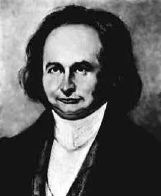

Carl Jacobi's early education was given by an uncle on his mother's side. When he was 11, he entered the Gymnasium in Potsdam. He was so advanced that while still in his first year of schooling, he was put into the final year class. This meant that he was still only 12 years old when he had reached the necessary standard to enter a university. However the
University of Berlin did not accept students below the age of 16, so Jacobi had to remain in the same class at the Gymnasium in Potsdam until then.
Of course, Jacobi pressed on with his academic studies despite remaining in the same class at school. He received the highest awards for Latin, Greek and
history but it was the study of mathematics which he took furthest. By the time Jacobi left school he had read advanced mathematics texts including those of Euler, and had been undertaking research on his own attempting to solve quintic equations by radicals.
Jacobi entered the University of Berlin in 1821 still unsure which topic he would concentrate on. He attended courses in philosophy, classics and mathematics for 2 years before choosing mathematics. Jacobi continued to study on his own, reading the works of Lagrange and other leading mathematicians. By the end of 1824, Jacobi had passed the examinations necessary for him to be able to teach mathematics, Greek, and Latin in secondary schools. Despite being Jewish, he was offered a teaching post at the Joachimsthalsche Gymnasium, one of the leading schools in Berlin.
He had submitted his doctoral dissertation to the University of Berlin, and he was allowed to move quickly to work on his habilitation thesis. Jacobi presented a paper concerning iterated functions to the Academy of Sciences in Berlin in 1825.
Around 1825 Jacobi converted to Christianity, which now made university teaching possible for him. By 1826 he was teaching at the University of Berlin, and then the
University of Königsberg. There he joined Neumann and Bessel.
Jacobi had already made major discoveries in number theory before arriving in Königsberg. Jacobi also had remarkable new ideas about elliptic functions. He wrote to several mathematicians, and Gauss and Legendre were much impressed by his results.
In 1829, Jacobi met Legendre, Fourier, Poisson, and Gauss on travels across Europe.
Jacobi and Euler were kindred spirits in the way they created their mathematics. Both were prolific writers and even more prolific calculators, both drew a great deal of insight from immense algorithmical work, both laboured in many fields of mathematics, and both at any moment could draw from the vast armoury of mathematical methods just those weapons which would promise the best results in the attack of a given problem.
In 1831, Jacobi was promoted to full professor after being subjected to a 4 hour oral exam. Jacobi's reputation as an excellent teacher attracted many students. He
introduced the seminar method to teach students the latest advances in mathematics.
In 1833, Jacobi's brother Moritz, a physicist, visited him in Königsberg. During the 2 years he spent there, Jacobi became more interested in physics. Jacobi carried out important research in partial differential equations of the first order and applied them to the differential equations of dynamics. He also worked on determinants and studied the functional determinant now called the Jacobian. Cauchy had studied the Jacobian earlierm but Jacobi wrote a long memoir devoted to the subject. He proved, among many other things, that if a set of n functions in n variables are functionally related then the Jacobian is identically zero, while if the functions are independent the Jacobian cannot be identically zero.
In 1834, Jacobi proved that if a single-valued function of one variable is doubly periodic then the ratio of the periods is imaginary. This result prompted much further work in this area, in particular by Liouville and Cauchy. One of the prettiest results in the global theory of curves is a theorem of Jacobi published in 1842: "The spherical image of the normal directions along a closed differentiable curve in space divides the unit sphere into regions of equal area".
In 1842, Jacobi was diagnosed with diabetes, and was advised to spend time in Italy.
The climate in Italy did indeed help Jacobi to recover and he began to publish again. He moved back to Germany, this time Berlin. He eventually moved to Gotha, while still lecturing in Berlin. He died of smallpox.